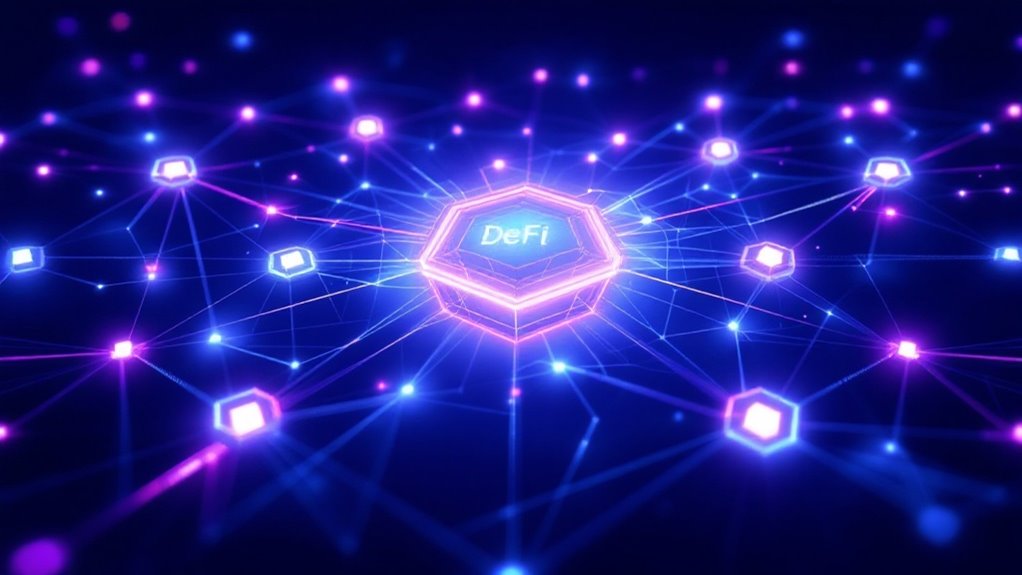Ethereum represents a groundbreaking digital ecosystem that functions like a vast, invisible computer spread across thousands of machines worldwide. Launched in 2015 by Vitalik Buterin, it revolutionized blockchain technology by introducing smart contracts – self-executing agreements that eliminate middlemen. Its native cryptocurrency, Ether (ETH), serves as digital fuel powering the network's operations. After shifting to proof-of-stake in 2022, Ethereum became more environmentally friendly, paving the way for a future where decentralized innovation knows no limits.

Innovation often arrives in waves, and Ethereum represents one of the most significant ripples in the blockchain revolution. Launched in 2015 by Vitalik Buterin, this decentralized platform has evolved into a digital ecosystem where traditional financial boundaries dissolve like morning mist.
Think of it as a vast, invisible computer spread across thousands of machines worldwide, humming with potential and possibility. At its heart beats Ether (ETH), the network's native cryptocurrency that flows like digital fuel through its virtual veins. Unlike Bitcoin's fixed supply, ETH maintains a flexible approach to monetary policy, adapting like a living organism to the network's needs.
Like a digital heartbeat echoing across the globe, Ethereum's network pulses with endless possibilities through its lifeblood, Ether.
Every 12 seconds, new blocks emerge, carrying with them transactions and changes that ripple across the digital landscape. The true magic of Ethereum lies in its smart contracts – self-executing agreements that run with the precision of a Swiss watch and the unwavering loyalty of a faithful servant. The Ethereum foundation's contributions were instrumental in bringing this revolutionary technology to life.
Written in Solidity, these digital contracts eliminate middlemen and create new possibilities for human interaction, from decentralized lending platforms to virtual art galleries. The Ethereum Virtual Machine (EVM) serves as the network's digital brain, processing transactions and updating the blockchain's state with mechanical efficiency.
This virtual computer never sleeps, never takes breaks, and never makes mistakes – it simply executes code exactly as written, creating a foundation for a new digital economy. Developers can leverage Ethers.js library to build and interact with these blockchain applications seamlessly. In 2022, Ethereum completed its most ambitious upgrade yet, evolving to a proof-of-stake system that slashed energy consumption by over 99%.
This change, like a butterfly emerging from its chrysalis, has made the network more sustainable and accessible to those who wish to participate through staking. Today, Ethereum stands as an affirmation of human ingenuity, hosting everything from decentralized finance protocols to digital art marketplaces. The platform has become a cornerstone for Web3 development, representing the next evolution of the internet.
Its rich ecosystem continues to grow, supported by a passionate community of developers and users who see in its lines of code the blueprint for a more open, accessible financial future. Like any technological revolution, it carries both promise and uncertainty, but its impact on the digital landscape is undeniable.
Frequently Asked Questions
How Many Ethereum Coins Can Be Mined in Total?
Unlike Bitcoin's fixed cap, Ethereum has no maximum supply limit. New ETH is continuously created through block rewards, while some is burned through transactions, making the total supply dynamic and fluctuating.
Why Does Ethereum Use More Energy Than Other Cryptocurrencies?
Ethereum historically used more energy due to its complex smart contract functionality, frequent transaction processing (every 12 seconds), and large network size. However, since shifting to Proof-of-Stake, energy usage dropped considerably.
Can Ethereum Replace Bitcoin as the Leading Cryptocurrency?
Ethereum could potentially surpass Bitcoin due to its advanced technology and diverse applications, but Bitcoin's established dominance, brand recognition, and role as digital gold make complete replacement unlikely in the near term.
What Happens to My ETH if the ETHereum Network Fails?
If the Ethereum network fails, ETH tokens remain in wallets but become temporarily inaccessible. While complete failure is unlikely, users may experience transaction delays and value fluctuations during partial outages or disruptions.
How Do I Convert My Ethereum Tokens Back to Regular Money?
ETH can be converted to fiat currency through cryptocurrency exchanges, P2P platforms, crypto ATMs, or direct-to-bank services. Each method requires account verification and varies in fees and processing times.









